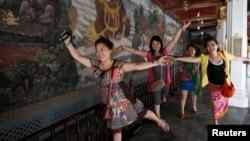Bad publicity about martial law, backpacker killings and police shakedowns of foreigners have harmed Thailand's reputation as a tourist magnet in past months. In 2015, the tourism industry is trying to attract more upscale visitors, as well as package tourists from China who are spending more per day than other nationalities.
From the hawkers on the Phuket beach to the managers in five-star Bangkok hotels, about one in ten Thais holds a job related to tourism.
The sector suffered last year amid political tension, with long-term street protests in Bangkok that culminated with a military coup.
Martial law remains in effect. That, and publicity overseas about tourists being victims of serious crimes on resort islands, police shaking down foreigners in the capital and taxi drivers overcharging fares, have combined to give many potential tourists second thoughts about visiting.
At Bangkok's Dusit Thani hotel, a five-star establishment dating back to 1970, general manager Sukanya Janchoo said the tourism sector has always managed to quickly bounce back from crises brought about by natural disasters, political troubles or economic downturns.
“We're challenged by nearly all the crises we have. We learn from that, it's one after the other. It's quite challenging but we are always able to manage it pretty well,” said Sukanya.
Known as the "Land of Smiles," Thailand hopes to put a happy face on the sector again this year and greet 28 million visitors - which was the numerical goal last year. In 2014, the total number of actual visitors was 26 million.
It's still a stunning total from the turn of the 21st century, when Thailand struggled to attract more than 10 million visitors annually. The total exceeded 15 million for the first time in 2010 and surged above 20 million in 2012.
But the goal for 2015 is not just a numerical target.
Varithorn Sirisattayawong, an analyst at the Kasikorn Research Center, said Thailand this year will try to move away from its image as a backpackers’ haven.
“If you look at the government agenda we try to attract the more quality tourists, more than quantity. In many tourist destinations we also have the place for the middle-group to the high-end tourist. Phuket or north in Chiang Mai we have hotels like five star and up. Then also the niche markets: health care, spas and things like that,” said Varithorn.
Sukanya, who is also the marketing and public relations chairperson for the Thai Hotels Association, said the transition upmarket is not going to be achieved quickly or easily.
“To drive from a mass one to be the quality one... It's quite a challenge. But, I think, it can be done. Maybe it takes a longer time. But we have to start,” said Sukanya.
China is now the largest single source of visitors to Thailand. The Chinese are considered the best spenders per capita on a daily basis. But their growing influence is not without controversy.
During this week's Chinese New Year period -- with 90,000 visitors from China expected -- many are receiving etiquette guides.
The brochures explain how to behave in museums and at temples, encourage proper rules for driving and warn against using public property as toilets.
Thailand is also popular with Malaysian, Japanese, Russian and South Korean visitors. But there has been a notable drop-off in Russian tourists with the ruble's recent plunge in value. A weakening euro against the Thai baht is blamed for a decline in visitors from European countries.
To make up for that slump, a special push is being made by the Association of Thai Travel Agents to boost the number of visitors from Indonesia, as well as from China.
Things are beginning to look up. The travel agents' association says its member companies report the total number of international tourists handled in January was up more than 18 percent compared to January of 2014.
Amid the increasing lure of nearby countries, especially neighboring Myanmar (also known as Burma) and Vietnam, where tourism infrastructure is being rapidly built, Thailand's travel industry this year has launched a "Discover Thainess" campaign to encourage more Thais to explore their own country.
A dozen out of the way "Don't Miss Destinations" are being pitched to Thais, as well as foreigners.
These include the numerous Burmese-style temples at Lampang, which has been spared the mass tourism development of nearby Chiang Mai and Chiang Rai.
Among other targeted destinations is underdeveloped Trang in the south, with its pristine beaches, and the province of Nakhon Si Thammarat, on the east coast of the Malay peninsula and the Gulf of Thailand. It was once known as the Kingdom of Ligor and still has diverse temple architecture, lush jungles, and a tradition of shadow puppets.









